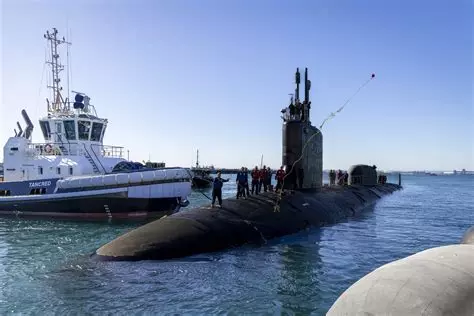A high-stakes investment beneath the Pacific surface
Australia has announced a staggering Aus$12 billion (US$8 billion) injection into the redevelopment of its Henderson Defence Precinct in Western Australia—an ambitious manoeuvre to retrofit its naval capabilities for the nuclear age. But this “nuclear submarine shipyard,” as it is now being positioned, is more than a domestic infrastructure project. It is the latest linchpin in a sprawling, costly, and increasingly uncertain strategic commitment: the AUKUS pact.
Behind the sterile press releases and carefully worded ministerial statements, one senses a deeper unease—a creeping awareness in Canberra that it is betting heavily on a geopolitical vision driven more by Washington’s needs than Australia’s own maritime imperatives.
The Henderson Pivot: Shipyard or Symbol?
Let’s state the obvious: Australia currently has neither the technical capacity nor the industrial backbone to maintain, let alone produce, nuclear-powered submarines. The decision to transform Henderson into a nuclear submarine shipyard is therefore less about immediate defence needs and more about signalling loyalty to the Anglosphere, namely the United States and the United Kingdom.
Defence Minister Richard Marles, in a tone bordering on appeasement, assured that “Henderson is very much an AUKUS project”, confirming that it will serve as the maintenance hub for future submarines, American, Australian, and potentially British. That admission is telling. This is not just a national project; it’s a proxy facility embedded in the broader architecture of American military logistics.
Yet it’s unclear whether the United States—mired in its own domestic rearmament debates and now re-evaluating the AUKUS framework under the second Trump administration—will ever deliver on its end of the deal. Meanwhile, Australia plunges headfirst into a program estimated to cost up to US$235 billion over 30 years, with only vague assurances of “positivity” from Washington.
AUKUS: Alliance or Dependency?
The AUKUS pact has been sold to the Australian public as a once-in-a-century security realignment. But strip away the diplomatic gloss, and one is left with a rather more sobering picture: Australia as the junior partner, footing an enormous bill to host and maintain foreign-built submarines, while hoping its allies won’t change course midstream.
Despite mounting concerns that the U.S. lacks the production capacity to fulfil both its own naval needs and Australia’s, the Albanese government insists the submarine programme is on track. Yet, it’s revealing that key affirmations about AUKUS’ future come not from official channels, but from leaked reassurances, in this case, U.S. Secretary of State Marco Rubio’s private conversations with Marles, as reported by the Washington Post.
This kind of diplomacy-by-whisper hardly inspires confidence.
An Expanding Arsenal, A Shrinking Sovereignty
The nuclear submarine shipyard investment is just one piece of a much larger militarisation puzzle. Since May 2022, Australia has committed over Aus$70 billion to defence spending. This includes:
- Aus$10 billion for 11 Japanese Mogami-class frigates,
- Aus$1.7 billion for a fleet of “Ghost Shark” underwater drones,
- and now Aus$12 billion for the Henderson expansion, with estimates that the total cost could eventually balloon to Aus$25 billion.
Yet amid the procurement frenzy, one must ask: where is the national strategic vision? Canberra appears content to play the role of staging ground for allied ambitions, rather than cultivating an independent deterrent posture rooted in Australian realities.
Strategic Autonomy, or Strategic Illusion?
The transformation of Henderson into a nuclear submarine shipyard is being marketed as a sovereign leap forward. In truth, it is a calculated concession, one that ties Australia’s defence trajectory to the uncertain fortunes of foreign powers, especially the increasingly erratic American political system.
The louder the officials talk of “positivity,” the more one senses unease beneath the surface. AUKUS may yet deliver submarines, but at what cost to Australia’s autonomy, credibility, and long-term interests?
The Pacific is militarising fast. Australia is responding, but not necessarily on its own terms.



